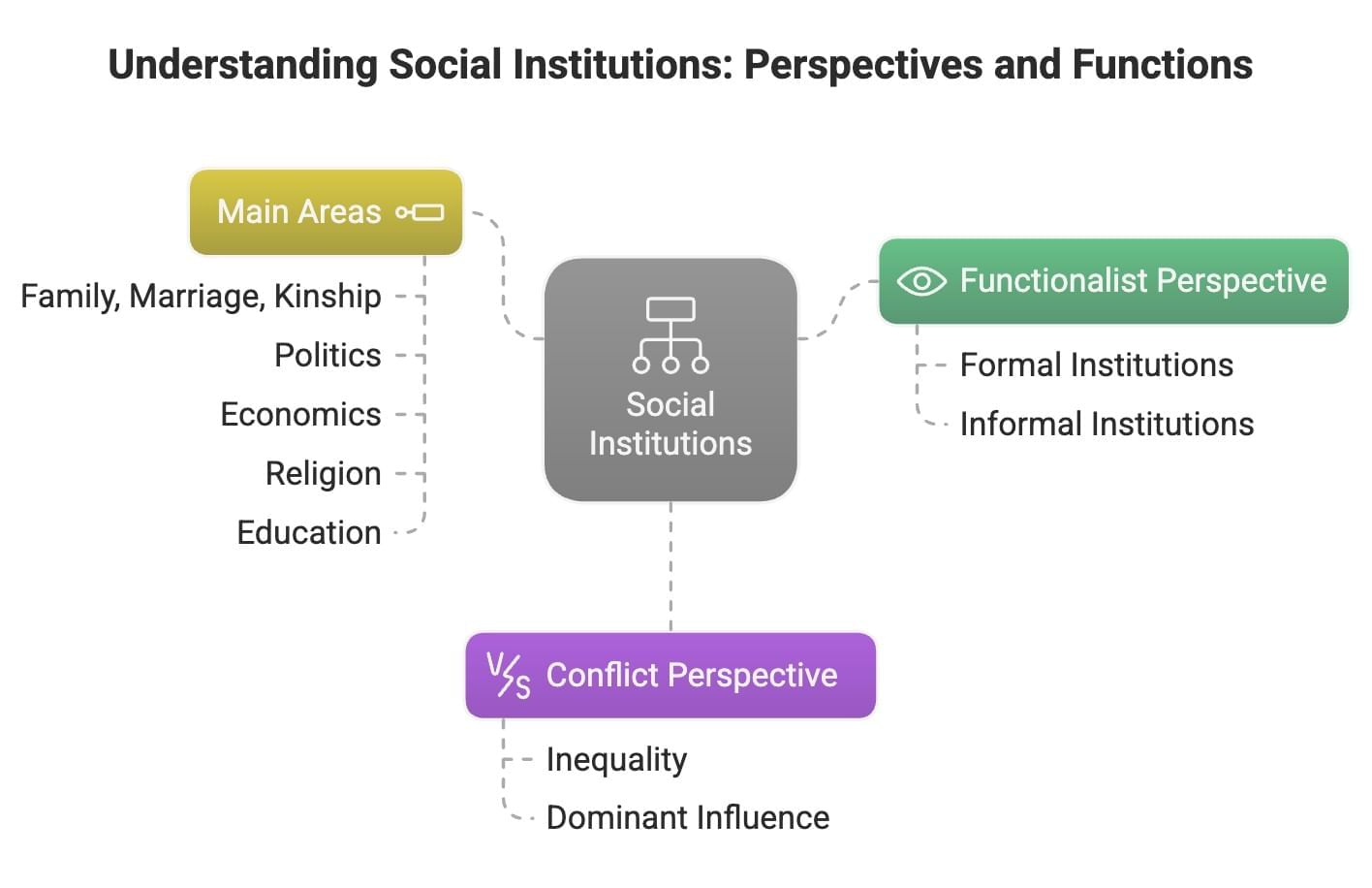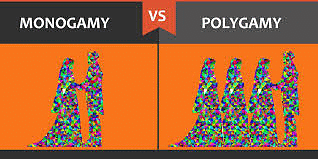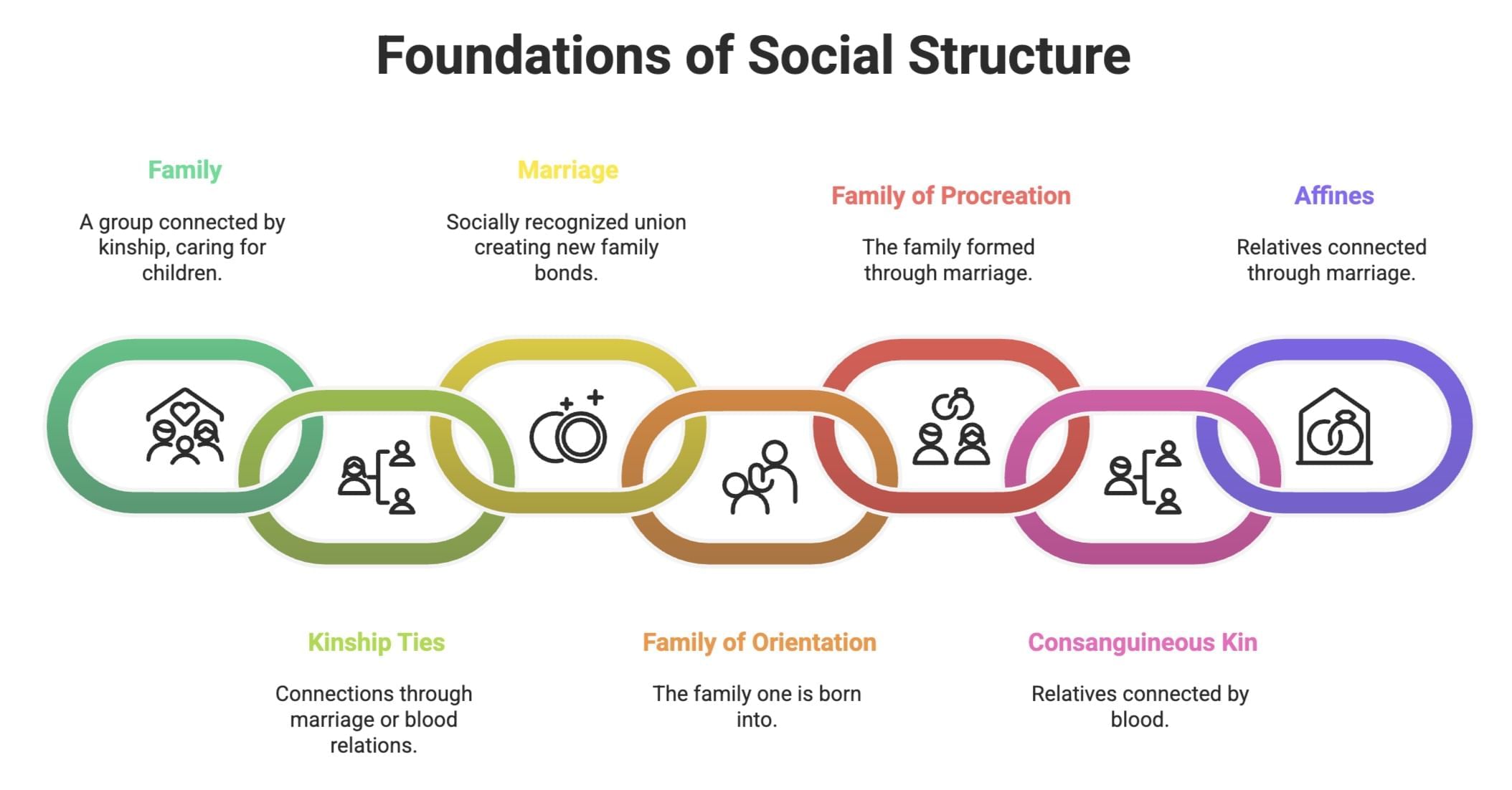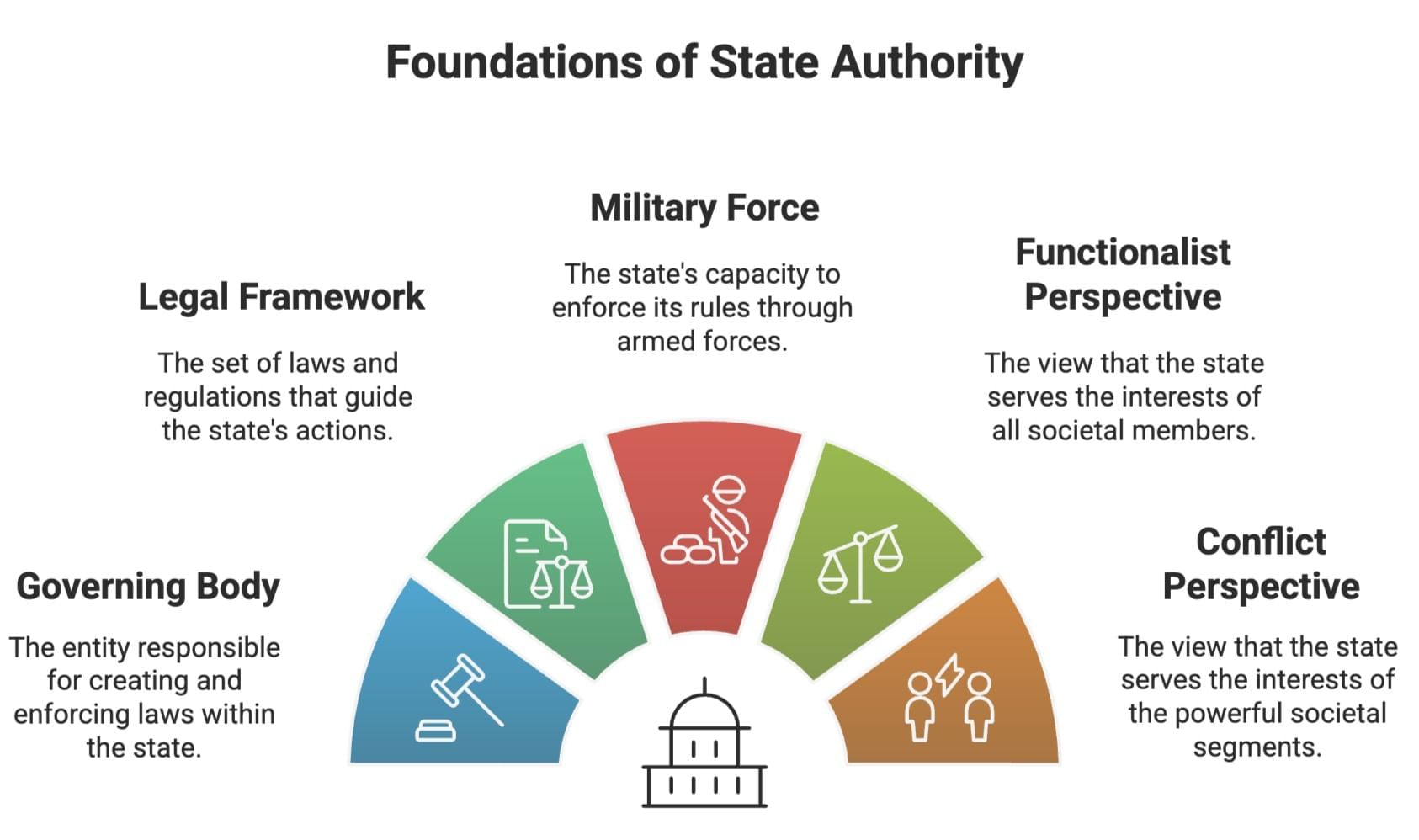Kinship refers to ties created through blood or marriage that link relatives.
Understanding Social Institutions Class 11 Sociology
| Table of contents |

|
| Introduction |

|
| Family, Marriage and Kinship |

|
| Work and Economic Life |

|
| Politics |

|
| Religion |

|
| Education |

|
| Important terms |

|
Introduction
Our status and role are predetermined and not subject to choice, unlike the roles an actor might play. Social institutions, including governmental and familial structures, impose limitations, punishments, and rewards on individuals.
Institutions
An institution is an entity that works according to set rules, either legal or traditional. Its proper working depends on following these rules, which guide and bind individuals. Institutions like family, religion, state, or education are often valued as important in themselves, not just for what they do.

For instance, family, church, state, and education are seen as both means to an end and as ends in themselves. The main areas where significant social institutions exist include: (i) family, marriage, and kinship; (ii) politics; (iii) economics; (iv) religion; and (v) education.
Sociological Perspectives
Functionalist View: Institutions are systems of norms, values, and roles that meet society’s needs. Family and religion are informal institutions; law and education are formal ones.
Conflict View: Institutions serve dominant groups, shaping politics, economics, and beliefs to maintain their power.
Family, Marriage and Kinship
A family is a group of individuals connected by blood, with adult members responsible for caring for children.
- Research in sociology and social anthropology shows that family, marriage, and kinship exist in all societies, though their forms differ.
- Functionalist Perspective: The family is essential for meeting basic needs and keeping social order. Functionalists argue that industrial societies work best when men earn income and women manage the home and childcare.
- Nuclear Family: Seen as the ideal for modern society, with a clear division of roles:
Husband: Breadwinner (instrumental role)
Wife: Caregiver (affective role)
Variation in Family Forms
- Shift in Family Structures: Sociologist A.M. Shah observed that since Independence, joint families in India have increased. Nuclear families, though always present, are more common among lower castes and classes.
- Increase in Joint Families: Rising life expectancy (men: 32.5 → 55.4 years, women: 31.7 → 55.7 years between 1941–50 and 1981–85) has led to more elderly people, many of whom live in joint households. This challenges the belief that joint families are declining.
- Female-Headed Households: When men migrate for work, women often manage farming and become main earners. Widowhood or men abandoning families can also lead to such households. Among the Kolam tribe (Maharashtra, Andhra Pradesh), female-headed households are accepted.
Family Structures
- Matrilocal: Living with wife’s parents
- Patrilocal: Living with husband’s parents
- Patriarchal: Male authority
- Matriarchal: Female authority (rare)
- Matrilineal: Lineage traced through the mother (more common than true matriarchal systems)
Families are Linked to Other Social Spheres and Families Change
- Family, household, and their structure are closely linked to economic and political spheres.
- German unification in the 1990s led to a decline in marriage due to the withdrawal of welfare schemes and protection for families.
- Economic insecurity post-unification influenced people to refuse marriage, illustrating unintended consequences.
- Family and kinship are subject to change due to macroeconomic processes, but the direction of change varies by country and region.
- Change does not mean the complete erosion of previous norms and structures; continuity and change can coexist.
How gendered is the family?
- Families often prioritise sons, believing they will support parents in old age, while daughters leave after marriage. This bias leads to greater investment in male children.
- Though girls biologically have higher survival chances, India shows higher infant mortality among female children.
Family and kinship are also shaped by economic changes, but the impact differs across regions. In practice, both tradition and change often coexist.
The Institution of Marriage
- Historically, marriage has existed in a wide variety of forms across different societies.
- Marriage has been observed to perform differing functions in various contexts.
- The methods by which marriage partners are arranged exhibit a remarkable variety of modes and customs.
Forms of Marriage

Variety of Marriage Forms:
Marriage differs in the number of partners and rules of eligibility.
Monogamy: One spouse at a time (one husband, one wife).
Polygamy: Multiple spouses at once.
Polygyny: One husband, several wives
Polyandry: One wife, multiple husbands
(Though possible, polygamy is less common than monogamy.)
Serial Monogamy: Remarriage after divorce or widowhood, but only one spouse at a time.
Widow Remarriage: Once restricted (especially among upper-caste Hindus) and debated during the 19th-century reforms. Today, about 10% of women and 55% of women over 50 are widows.
Polyandry and Poverty: Polyandry often arises in poor communities where one man cannot support a family, helping control population under harsh conditions.
The Matter of Arranging Marriages: Rules and Prescriptions
Mate selection varies across communities, with some allowing individuals to freely choose their own partners, while others involve parents or relatives in making such decisions.Rules of Endogamy and Exogamy
Endogamy: Marriage within a defined group (e.g., caste).
Exogamy: Marriage outside one’s group (e.g., clan, village, religion).
In India, some northern regions practise village exogamy, where daughters marry into distant villages. This helps brides adjust to new families and limits interference from their natal kin.
Because of patrilineal traditions and distance, married daughters visit their parents less often. Folk songs often express the sorrow of leaving one’s natal home.
Defining Some Basic Concepts, Particularly Those of Family, Kinship and Marriage
- Family: A family is a group of people connected by kinship, where adult members take care of children.
- Kinship Ties: These are connections between people formed either by marriage or through blood relationships (like mothers, fathers, siblings, and children).
- Marriage: This is a socially recognised and accepted union between two adults. When individuals marry, they become relatives to each other, and this bond extends to their families, making parents, siblings, and other relatives related through the marriage.
- Family of Orientation: This refers to the family one is born into.
- Family of Procreation: This is the family formed when a person gets married.
- Types of Kin:
1. Consanguineous Kin: Relatives connected by blood.
2. Affines: Relatives connected through marriage.

Work and Economic Life
What is Work?
- Work is more than just paid jobs. Many forms, especially in the informal economy (cash payments or direct exchanges), are often left out of official statistics.
- In simple terms, work means doing tasks—using mental or physical effort—to produce goods or services that meet human needs, whether paid or unpaid.
Modern Work Forms and Labour Division
- Pre-Modern Societies: Most people worked in agriculture or animal husbandry. Even today, many in India depend on rural and farm-based occupations.
- Modern Economic Systems: Modern economies feature a complex division of labour with many specialised jobs, unlike traditional societies where non-farm work was mostly craft-based.
- Work and Industrialisation: Before industrialisation, households worked together at home. With new technology (coal, electricity), work shifted to factories run by capitalist entrepreneurs, separating home and work.
- Specialised Employment: Factory workers were trained for specific tasks and paid for their skills. This specialisation is central to modern society.
- Economic Interdependence: In modern life, people rely on others for food, housing, and goods, showing strong interdependence.
Transformation of Work
- Modern industry introduced mass production, enabled by mass markets and innovations like the moving assembly line. This system relied on costly machines and close employee monitoring.
- In recent times, work has shifted toward flexible production and decentralisation, driven by globalisation and competition. Production now adapts quickly to changing market demands.
Politics
Political institutions manage how power is distributed in society.
- Power: The ability to achieve goals despite opposition, often benefiting those in power. Power is relational, and the total power in a society is limited.
- Authority: The legitimate use of power to make decisions or enforce rules. Examples include a school principal enforcing discipline or a political party leader expelling members. Authority is respected because it is seen as fair and justified.
Stateless Societies
- Empirical studies of stateless societies by social anthropologists over sixty years ago showed how order is kept without modern government systems.
- Instead, there was a balance between different groups; alliances formed through family ties, marriage, and living arrangements; and ceremonies that included both friends and enemies.
- Rites and ceremonies that involve both friends and foes help maintain order.
- Modern states have a fixed structure and formal procedures. However, do some of the informal methods seen in stateless societies also exist in state societies?
The Concept of the State
A state is defined as a political system with a governing body (such as a parliament or congress along with civil servants) that exercises authority over a specific area. This authority is supported by legal frameworks and the ability to use military force to enforce its rules.
Functionalist Perspective: This view holds that the state acts in the best interests of all parts of society.
Conflict Perspective: This perspective argues that the state serves the interests of the powerful segments of society.

Modern States
Modern states differ from traditional ones and are defined by sovereignty, citizenship, and often nationalism.
Sovereignty: Full political control over a territory.
Citizenship Rights:
Civil Rights: Freedom of movement, speech, religion, property, and justice.
Political Rights: Right to vote and hold office.
Social Rights: Economic support, like health care and minimum wage. Social/welfare rights led to welfare states in Western countries after WWII, though less common in developing nations.
Nationalism: A sense of belonging to a political community (e.g., Indian, British) that arose with modern states.
Contemporary Issues
Global markets, nationalist conflicts, and social inequalities affect power distribution. Sociologists study how power operates not only in governments but also among parties, classes, castes, and communities defined by race, language, or religion.
Religion
Sociologists study religion differently from believers, focusing on its social role and effects.
- Sacred and Profane: Following Durkheim, the sacred is set apart from the profane. It may include the supernatural, though some religions (like early Buddhism or Confucianism) see certain things as sacred without invoking the supernatural.
- Sociological Examination: Looks at religion’s connections with other institutions and its influence on power and politics.
- Historical Movements: Religious movements have driven social change, addressing caste, gender, and inequality.
- Public and Private: Religion affects both personal beliefs and public life, influencing other societal institutions.
- Secularisation: Classical sociologists predicted that modernisation would reduce religion’s influence. However, religion remains significant today.
- Max Weber: Linked Calvinism to the rise of capitalism, showing how religion affects economic behaviour and investment.
- Influences on Religion: Religious norms both shape and are shaped by politics, economics, and gender.
- Women and Religion: The role of women in religion is an important area of sociological study.
- Integration with Society: Religion connects with other social aspects and is central to traditional societies, blending with material and artistic culture.
Sociological Methods:
Empirical: Observing religion in practice
Comparative: Comparing religions across societies
Relational: Studying links between religion and domestic, economic, and political life
- Common Features: Religions often include symbols, rituals (praying, chanting, fasting), and a community of believers, practised in sacred spaces like temples, mosques, or churches.
- Sacred Realms: Approached with awe and respect, often involving special rituals and dress codes.
Education
Education is a lifelong process involving both formal and informal learning.
Here, the focus is on school education.
Admission to school is crucial for many, serving as a gateway to higher education, employment, and the acquisition of social skills.
Sociology views education as a transmission of group heritage, common to all societies, with distinctions between simple societies and complex, modern societies.
In simple societies, education was informal, with children learning customs and life skills through participation with adults.
Complex societies require formal education due to the economic division of labour, separation of work from home, and the need for specialised learning.
In modern societies, education is formal and explicit due to abstract universalistic values, as opposed to the particularistic values of simple societies.
Modern schools promote uniformity, standardised aspirations, and universalistic values. Examples include a uniform dress for school children.
Emile Durkheim argued that society needs a common base of ideas, sentiments, and practices that education must inculcate in all children, regardless of their social category.
Education prepares children for specific occupations and helps them internalise the core values of society. It maintains and renews the social structure and transmits culture.
According to functionalist sociologists, education also serves as a mechanism for the selection and allocation of individuals into future societal roles and statuses based on their abilities.
For sociologists who view society as unequally differentiated, education acts as a stratifying agent and reflects social stratification.
Educational opportunities vary based on socio-economic background, leading to differences in privileges and opportunities.
Privileged schooling can intensify the divide between the elite and the masses, affecting confidence and opportunities.
Many children cannot attend school or drop out, which perpetuates inequality in educational attainment and future opportunities.
Important terms
Citizen: An individual who is part of a political community, with both rights and responsibilities associated with that membership.
Division of Labour: The specialisation of work tasks where different occupations are integrated into a production system. While all societies have some form of division of labour, industrialism greatly enhances this complexity, making it international in scope in the modern world.
Gender: Socially defined expectations about appropriate behaviour for each sex, serving as a fundamental organising principle in society.
Empirical Investigation: The process of factual inquiry conducted within a specific area of sociological research.
Endogamy: The practice of marrying within a particular caste, class, or tribal group.
Exogamy: The practice of marrying outside a specific group of relations.
Ideology: Shared beliefs or ideas that justify the interests of dominant groups, prevalent in societies with systemic inequalities. Ideologies are linked with power, as they legitimise the unequal distribution of power among groups.
Legitimacy: The perception that a political system or order is just and valid.
Monogamy: A marital arrangement involving one husband and one wife exclusively.
Polygamy: A marital arrangement where an individual has more than one spouse simultaneously.
Polyandry: A form of polygamy where one woman is married to multiple men.
Polygyny: A form of polygamy where one man is married to multiple women.
Service Industries: Sectors focused on producing services rather than goods, such as the travel industry.
State Society: A society with a formal system of government institutions.
Stateless Society: A society without formal governmental institutions.
Social Mobility: The ability to move between different social statuses or occupations.
Sovereignty: The ultimate and uncontested political authority of a state over a defined territorial area.
|
41 videos|105 docs|17 tests
|
FAQs on Understanding Social Institutions Class 11 Sociology
| 1. What are the key social institutions discussed in the article? |  |
| 2. How do social institutions impact individuals and societies? |  |
| 3. What is the significance of understanding social institutions in humanities and arts? |  |
| 4. How do social institutions like family and education contribute to socialization? |  |
| 5. How do social institutions evolve and change over time? |  |
















